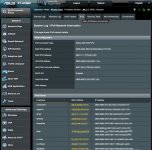You are using an out of date browser. It may not display this or other websites correctly.
You should upgrade or use an alternative browser.
You should upgrade or use an alternative browser.
Diversion Resolve IPv6 Hostnames
- Thread starter zaxcom
- Start date
ColinTaylor
Part of the Furniture
Set "Diversion" as the prefix of your thread title, otherwise it's confusing.
thelonelycoder
Part of the Furniture
That depends, if the router UI resolves it and writes it to one of the files that Diversion checks then yes it will do it, otherwise there is no way for my software to get that info.Is there a way for Diversion to resolve client names in IPv6 instead of just showing the client address?
I am on an RT-AX86U, with the latest version of Merlin. How would one go about looking to see if the router can write to the files?That depends, if the router UI resolves it and writes it to one of the files that Diversion checks then yes it will do it, otherwise there is no way for my software to get that info.
thelonelycoder
Part of the Furniture
That‘s the MAC address, not IPv6 address. Diversion does not have that info.Looks like the router resolves the names.
ColinTaylor
Part of the Furniture
Which page of the GUI is that? I don't recognise it.Looks like the router resolves the names.
Says its the IP address in the column headerThat‘s the MAC address, not IPv6 address. Diversion does not have that info.
5stringdeath
Regular Contributor
The system log on my router has the same information. There are three columns:That‘s the MAC address, not IPv6 address. Diversion does not have that info.
Hostname / MAC Address / IP Address (which are IPv6's)
My router shows information in each column for devices.
Referring to System Log / IPV6 tab
dave14305
Part of the Furniture
After you’ve viewed the tab in the GUI, you could find the info in
I’m not sure how useful it would be in any historic reports if using IPv6 SLAAC addresses. Too many to keep track of in my opinion.
/tmp/ipv6_client_info. The GUI collects it by running the equivalent of ip -f inet6 neigh show dev br0 | grep lladdr and parsing the MACs with the host details.I’m not sure how useful it would be in any historic reports if using IPv6 SLAAC addresses. Too many to keep track of in my opinion.
SomeWhereOverTheRainBow
Part of the Furniture
I agree with dave here. IPv6 addressing can range from rather challenging to near impossible regarding adequate ipv6 hostname implementation. Pihole utilizes a very sophisticated method which relies on the storing historic connection information about the clients. Still, even with such a sophisticated method, the multiple(and temporary) addressing challenges of SLAAC proved to be too much of a bother. Piholes "default" method only holds on to the most recent information regarding ipv6 clients. Otherwise users have to turn on a resolving ipv6 address feature that performs information renew lookups similar to how the ipv4 does. Then users quickly see how those ipv6 addresses quickly fill up with multiple SLAAC addressing per client.After you’ve viewed the tab in the GUI, you could find the info in/tmp/ipv6_client_info. The GUI collects it by running the equivalent ofip -f inet6 neigh show dev br0 | grep lladdrand parsing the MACs with the host details.
I’m not sure how useful it would be in any historic reports if using IPv6 SLAAC addresses. Too many to keep track of in my opinion.
At that point, it really boils down to if it is worth it.
Last edited:
sfx2000
Part of the Furniture
FWIW - in my internal openwrt builds, I use mDNS/Avahi to resolve internal IPv6/IPv4 hostnames...
And I just worry about the link-local records, not the global scope ones, as those can/do change - link-local (fe80::/10) are typically consistent with the MAC addr associated with it.
MAC addr, since this is lower layer, you can correlate the IPv4 and IPv6 entries accordingly...
Note - I use avahi, but a combo of ARP (ipv4) and NDP (ipv6) can do the same thing, and now thinking about it, I might rejigger my implementation to see if that is more effective or not...
And I just worry about the link-local records, not the global scope ones, as those can/do change - link-local (fe80::/10) are typically consistent with the MAC addr associated with it.
MAC addr, since this is lower layer, you can correlate the IPv4 and IPv6 entries accordingly...
Note - I use avahi, but a combo of ARP (ipv4) and NDP (ipv6) can do the same thing, and now thinking about it, I might rejigger my implementation to see if that is more effective or not...
SomeWhereOverTheRainBow
Part of the Furniture
For my network, I have a secondary custom prefix that I advertise with DNSMASQ because my gua prefix changes often. And no I am not talking about NATTING ULA Prefixes, each device still gets their own address from the main prefix, but internal name resolution between devices is done with the secondary custom prefix. My br0 interface still gets the main prefix, but I have a script that creates another generic prefix that doesn't change for communication and name resolution within my network. Basically, so I can have a static internal addressing setup, while at the same time i don't really care about the external route-able addresses changing.FWIW - in my internal openwrt builds, I use mDNS/Avahi to resolve internal IPv6/IPv4 hostnames...
And I just worry about the link-local records, not the global scope ones, as those can/do change - link-local (fe80::/10) are typically consistent with the MAC addr associated with it.
MAC addr, since this is lower layer, you can correlate the IPv4 and IPv6 entries accordingly...
Note - I use avahi, but a combo of ARP (ipv4) and NDP (ipv6) can do the same thing, and now thinking about it, I might rejigger my implementation to see if that is more effective or not..
Last edited:
Similar threads
- Replies
- 1
- Views
- 439
- Replies
- 19
- Views
- 2K
- Replies
- 10
- Views
- 1K
Similar threads
Similar threads
Latest threads
-
-
-
Asus RT-BE86U, 4TB USB disk support?
- Started by Pavel_S
- Replies: 1
-
-
Happy New Year to our Asuswrt-Merlin Addon Community! RTRHTR v1.5 RELEASE CELEBRATION!
- Started by Viktor Jaep
- Replies: 21
Support SNBForums w/ Amazon
If you'd like to support SNBForums, just use this link and buy anything on Amazon. Thanks!
Sign Up For SNBForums Daily Digest
Get an update of what's new every day delivered to your mailbox. Sign up here!


